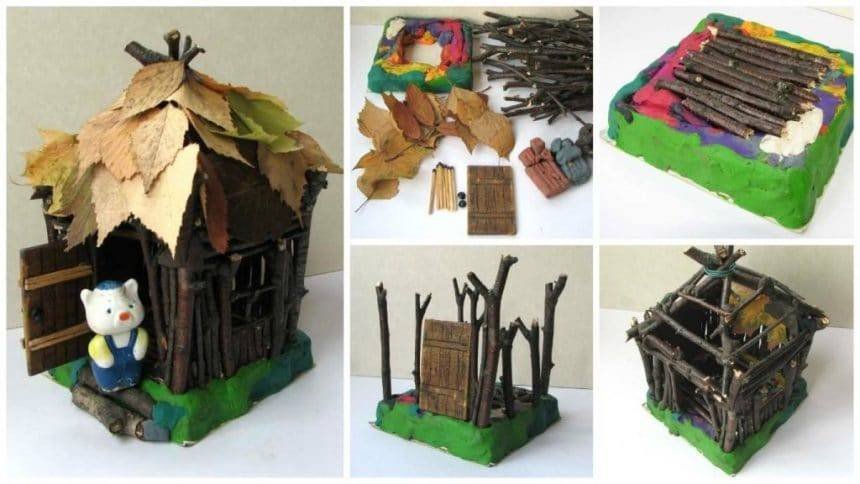How to make house from branches
Decided to build a house out of twigs. Maybe he just started to build a tent – but we’ll see how you can branch out to build a real house. Wooden houses are very diverse, but before there were complex systems – for example, log or half-timbered, wooden built very simply – hammering stakes into the ground. Everyone knows this method – a stockade – he later was in the construction of fences and even now remains in landscape architecture. And playgrounds can often find columns on which to jump so well.
Materials for house : base (cardboard – size ~ 15×15 cm.), Clay (bright chemical colors go into a foundation for securing branches using brown, black and gray, and a little green to strengthen the bottom), threads (preferably birch – they break easily in the right place, have knots and they can always be found under birch trees at any time of the year) (in size comfortable birch), dried leaves for a roof, and a rope (or wire) – tie beams on the roof. For house door, you can take a piece of wood (I have sawn off line) or veneer or cork coasters (include fantasy), a few matches and beads pen. But you can make it even easier to door – frame made of branches and a large maple leaf filling.
So, for what would have held a palisade – stakes (in this case branches) should be properly strengthened in the ground (as far as possible). Actually, the real construction of the foundations of the construction (zero cycle) have 30 or even 40% of the time and finances. So that we are not lazy and laid a layer of clay is 1.5 cm. The thicker the clay, the stronger will keep branches and the easier it will be to adjust their height. If you have an old clay unnecessary – you can make a coherent stand – if not – the center can be covered with branches and have to make the floor in our house. Although pig Nuf- Nufa, think the floor was just well trodden ground.
We start to put the rack. First four corner rack, then place on rack doors (here to determine its size it would be good for sure), and in place of the window. These racks are based roofing beams – they are the most thick (thickness from about ordinary pencil) and the top of the left fork in the road for what would have been easier for them to fix. (Question – which end is usually hammered pegs in palisade and why butt up that tree would not suck the water and the soil is rotten?
Now fill panes space – put the little bars on them on plasticine beam-sill. Next, put the jumpers of the beam above the window and the door. You can make them shorter, but that would be held on the racks. But it is easier (and stronger) make their long and fill the space above them as the horizontal branches (like a log).
Fill the walls with vertical branches as closely as possible. This house Nuf- Nuf would score gap with moss, we can caulk their plasticine or glue inside the dry leaves. This work is done after the construction of the whole structure – but it is better to do it now – is no roof and is not difficult to crawl to the corners.
Put the rafters – connect them together and on top of, not sparing plasticine, fasten them to the posts at the corners. Now is the time to see the entire structure, strengthen its clay and caulked holes.
On plasticine fasten horizontal beams – that would pile up on the roof of leaves
The cut of the roof always with the bottom row (why?). First, the bottom row of leaves (tiles, sheets or slate roofing iron, etc. – generally work for any material), then at him from the bottom of the second, etc
It remains to make binding the window (of the little twigs on the plasticine), the door (main door paint marker boards, paste the match – cross boards that hold the fabric, and fasten plasticine beads pen, and put in a doorway can make to. wire loops that have the door of the opened and closed) and put small-scale pig.
The same principle is made half-timbered house – put the rack, stand out windows and doors, there are diagonal to the fortress and spatial rigidity, and the walls are filled with do not have a palisade, and the fact that there are at hand – clay, stone, debris, etc. .
Courtesy: noarov.ru
























